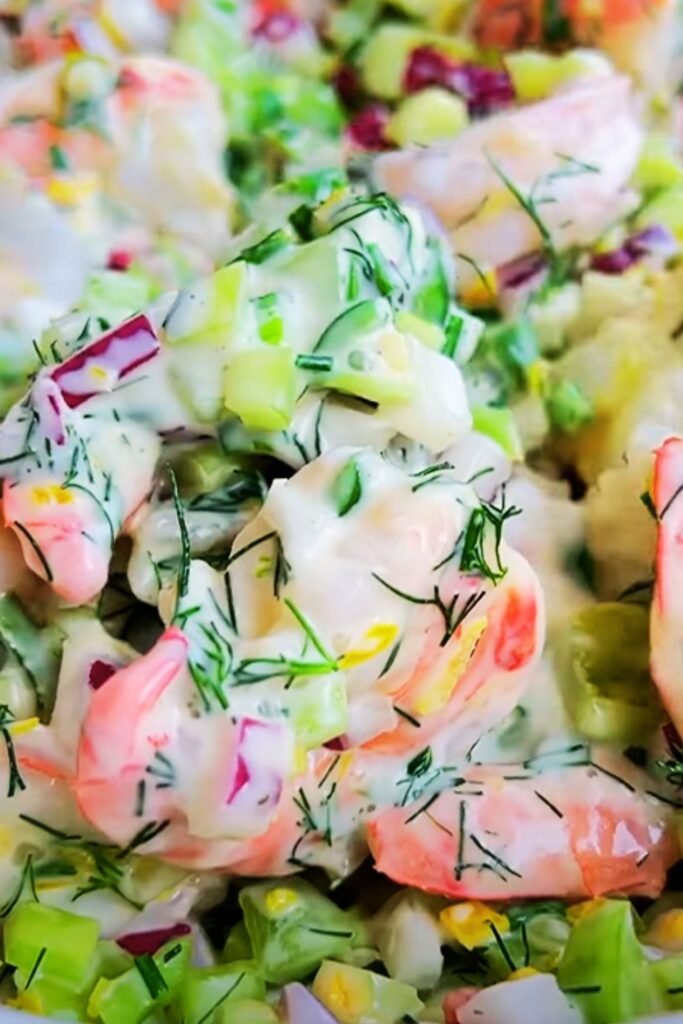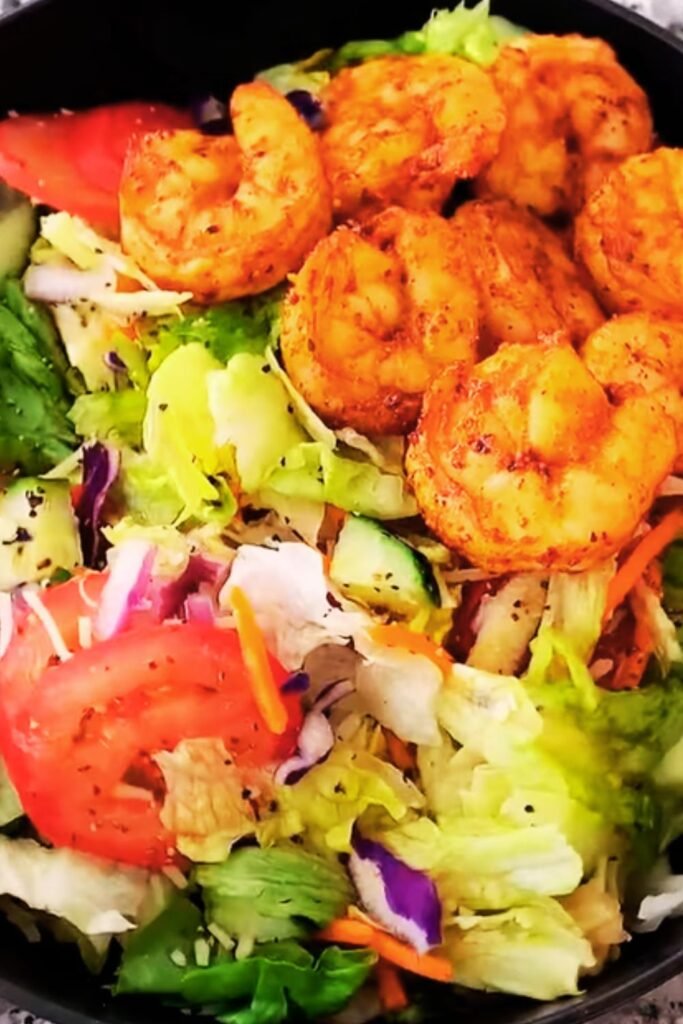There’s something utterly satisfying about a well-made cold shrimp salad on a warm day. I’ve been perfecting this recipe for years, and it’s become my go-to dish for everything from casual lunches to elegant dinner parties. The beauty of this simple cold shrimp salad lies in its versatility and the way it allows the delicate flavor of shrimp to shine through while being complemented by crisp vegetables and a light, zesty dressing.
What I love most about this recipe is how it manages to be both refreshing and satisfying. The succulent shrimp provides protein that makes the salad substantial enough to serve as a main course, while the fresh vegetables and herbs keep it light and vibrant. Plus, it can be prepared in advance, making it perfect for busy days or when you’re entertaining guests.
In this article, I’ll walk you through my foolproof method for creating the perfect cold shrimp salad, share some expert tips on selecting and preparing shrimp, and offer variations to suit different taste preferences and dietary needs. Whether you’re a seafood enthusiast or just looking to expand your repertoire of easy, impressive dishes, this recipe is bound to become a favorite in your collection.
The Perfect Shrimp: Selecting and Preparing
Before diving into the recipe itself, let’s talk about the star of our dish—the shrimp. Choosing the right shrimp and preparing them properly is crucial for a delicious result.
Selecting Quality Shrimp
When I shop for shrimp, I pay attention to several factors:
- Size: For this salad, I prefer medium to large shrimp (21-30 count per pound). They’re substantial enough to be satisfying but not so large that they overwhelm the other ingredients.
- Fresh vs. Frozen: While fresh shrimp is wonderful if you live near the coast, high-quality frozen shrimp is often a better option for most of us. Most “fresh” shrimp at supermarkets has actually been previously frozen anyway.
- Wild vs. Farmed: Wild-caught shrimp generally has better flavor, but sustainable farmed shrimp can be a good alternative if wild-caught isn’t available.
- Shell-on vs. Peeled: I typically buy shell-on shrimp and peel them myself, as the shells add flavor when cooking. However, if time is tight, peeled and deveined shrimp is perfectly acceptable.
- Appearance: Look for shrimp with a clean, oceany smell (never ammonia-like), firm texture, and translucent, grayish-pink color.
Proper Thawing Technique
If using frozen shrimp (as most of us do), proper thawing is essential:
- Place the frozen shrimp in a colander or strainer
- Set it in a large bowl
- Run cold water over the shrimp for about 5 minutes, tossing occasionally
- Alternatively, thaw overnight in the refrigerator for the best texture
Never thaw shrimp at room temperature or use hot water, as this can lead to uneven thawing and potential food safety issues.
Perfect Cooking Method
For the best-tasting shrimp that’s tender and not rubbery, I follow this simple poaching method:
- Fill a large pot with water (about 3 quarts)
- Add 2 tablespoons of salt, 1 lemon cut in half and squeezed (throw the halves in too), a few peppercorns, and a bay leaf
- Bring to a boil, then reduce to a simmer
- Add the peeled and deveined shrimp
- Cook just until they turn pink and opaque, about 2-3 minutes for medium shrimp
- Immediately transfer to an ice bath to stop the cooking process
- Once cooled, pat dry with paper towels before adding to the salad
This gentle poaching method preserves the shrimp’s sweet flavor and ensures a perfect texture that’s tender, not rubbery. The quick cooling in an ice bath is crucial—it stops the cooking process immediately, preventing the shrimp from becoming tough and overcooked.
Simple Cold Shrimp Salad Recipe
Now that we understand the fundamentals of preparing perfect shrimp, let’s dive into the full recipe for my favorite cold shrimp salad.
Ingredients
For the Shrimp:
- 2 pounds medium shrimp (21-25 count), peeled and deveined
- 2 tablespoons kosher salt (for poaching water)
- 1 lemon, halved and juiced (reserve the halves)
- 1 bay leaf
- 1 teaspoon black peppercorns
For the Salad:
- 1 cup celery, finely diced (about 3 stalks)
- 1/2 cup red bell pepper, finely diced
- 1/3 cup red onion, finely diced
- 2 tablespoons fresh dill, chopped
- 2 tablespoons fresh parsley, chopped
- 1 tablespoon capers, drained and roughly chopped (optional)
For the Dressing:
- 1/2 cup good-quality mayonnaise
- 2 tablespoons plain Greek yogurt
- 1 tablespoon Dijon mustard
- 1 tablespoon fresh lemon juice
- 1 teaspoon lemon zest
- 1 small garlic clove, minced or grated
- 1/4 teaspoon Old Bay seasoning (optional)
- Salt and freshly ground black pepper to taste
For Serving:
- Butter lettuce leaves
- Sliced avocado
- Cherry tomatoes, halved
- Lemon wedges
- Additional fresh herbs for garnish
Instructions
Step 1: Cook the Shrimp
- Fill a large pot with about 3 quarts of water
- Add salt, lemon juice and squeezed lemon halves, bay leaf, and peppercorns
- Bring to a boil, then reduce to a simmer
- Add the peeled and deveined shrimp
- Cook until just pink and opaque, about 2-3 minutes
- Prepare an ice bath while the shrimp cook
- Using a slotted spoon, transfer cooked shrimp immediately to the ice bath
- Let cool completely, about 5 minutes
- Drain well and pat dry with paper towels
Step 2: Prepare the Shrimp
- Once the shrimp are cooled and dried, cut them into bite-sized pieces (I usually cut them in half or thirds, depending on size)
- Place in a large mixing bowl
Step 3: Prepare the Vegetables
- Add the diced celery, red bell pepper, red onion, fresh dill, parsley, and capers (if using) to the bowl with the shrimp
- Toss gently to combine
Step 4: Make the Dressing
- In a separate small bowl, whisk together the mayonnaise, Greek yogurt, Dijon mustard, lemon juice, lemon zest, minced garlic, and Old Bay seasoning (if using)
- Season with salt and freshly ground black pepper to taste
Step 5: Combine and Chill
- Pour the dressing over the shrimp mixture
- Fold gently until everything is evenly coated
- Cover and refrigerate for at least 1 hour (or up to 24 hours) to allow the flavors to meld
Step 6: Serve
- Line a serving platter or individual plates with butter lettuce leaves
- Spoon the shrimp salad onto the lettuce
- Garnish with sliced avocado, cherry tomatoes, lemon wedges, and additional fresh herbs
- Serve chilled

Nutritional Information
Understanding the nutritional content of this dish can help you incorporate it into a balanced diet. Here’s a breakdown of the approximate nutritional values per serving (assuming 6 servings from the recipe):
| Nutrient | Amount | % Daily Value* |
|---|---|---|
| Calories | 245 | – |
| Total Fat | 14g | 18% |
| Saturated Fat | 2.5g | 13% |
| Cholesterol | 220mg | 73% |
| Sodium | 690mg | 30% |
| Total Carbohydrate | 5g | 2% |
| Dietary Fiber | 1g | 4% |
| Sugars | 2g | – |
| Protein | 26g | 52% |
| Vitamin A | – | 15% |
| Vitamin C | – | 30% |
| Calcium | – | 8% |
| Iron | – | 15% |
*Percent Daily Values are based on a 2,000 calorie diet.
This shrimp salad is high in protein and relatively low in carbohydrates, making it a satisfying option for those following various dietary approaches, including low-carb and keto diets.
Expert Tips for the Perfect Shrimp Salad
Over years of making this salad, I’ve discovered several tricks that elevate it from good to exceptional:
1. Proper Shrimp Temperature
Allow your shrimp to come to room temperature for about 10-15 minutes before serving. Cold temperatures can dull flavors, and a slight warming allows the full complexity of the dish to shine through.
2. Texture Balance
Dice your vegetables consistently and relatively small. The goal is to have them complement the shrimp, not compete with it. I aim for pieces about 1/4-inch in size.
3. Make-Ahead Strategy
This salad actually improves with time as the flavors meld. I often make it the night before I plan to serve it, but I add the herbs just before serving to preserve their bright color and flavor.
4. Seasoning Secret
Always taste the salad after it’s been chilled. Cold temperatures suppress flavors, so you may need to adjust the seasoning right before serving, adding an extra squeeze of lemon or pinch of salt.
5. Serving Temperature
Remove the salad from the refrigerator about 15 minutes before serving. Extreme cold can dull the flavors, but you still want it pleasantly chilled.

Variations to Try
One of the reasons I love this basic recipe is how easily it can be adapted. Here are some delicious variations I’ve developed over the years:
Mediterranean Style
- Add diced cucumber, kalamata olives, and crumbled feta cheese
- Replace some of the mayonnaise with olive oil
- Add oregano and a splash of red wine vinegar
- Serve with warm pita bread
Asian Fusion
- Add grated ginger and a splash of sesame oil to the dressing
- Skip the Old Bay and add a touch of sriracha or chili garlic sauce
- Mix in thinly sliced snow peas and water chestnuts for crunch
- Garnish with sliced scallions and sesame seeds
- Serve over rice noodles or in lettuce cups
Tex-Mex Twist
- Add diced avocado, black beans, and corn
- Mix in chopped cilantro and lime juice instead of dill and lemon
- Add a dash of cumin and chili powder to the dressing
- Serve with tortilla chips or as a filling for lettuce wraps
Curry Version
- Add 1-2 teaspoons of curry powder to the dressing
- Mix in diced apple and golden raisins
- Add toasted slivered almonds for crunch
- Serve over a bed of baby spinach
Serving Suggestions and Pairings
This versatile shrimp salad can be presented in multiple ways:
As a Main Course
- Serve a generous portion over butter lettuce with crusty bread on the side
- Stuff into avocado halves for an elegant lunch
- Spoon into hollowed-out tomatoes for a beautiful presentation
- Use as a filling for a croissant or wrap for a portable lunch
As an Appetizer
- Serve small portions in endive leaves or on cucumber rounds
- Provide as a dip with crackers or crostini
- Fill cherry tomatoes for bite-sized hors d’oeuvres
- Serve in small glasses or cups as an elegant starter
Refreshing Drink Pairings
- Sparkling water with lemon or cucumber
- Unsweetened iced tea with mint
- Homemade lemonade
- Cucumber-infused water
Side Dishes That Complement
- Fresh fruit salad
- Chilled gazpacho
- Simple green salad with vinaigrette
- Marinated vegetable antipasto

Storing and Make-Ahead Tips
This shrimp salad is an excellent make-ahead dish, but proper storage is important for both safety and quality:
Storage Guidelines
- Store the salad in an airtight container in the refrigerator
- Properly stored, it will keep for up to 2 days
- Do not freeze this salad—the texture of both the shrimp and vegetables will suffer significantly
Make-Ahead Strategy
If preparing more than a day in advance, consider these steps:
- Cook and chill the shrimp
- Prepare the dressing and store separately
- Chop the vegetables and herbs and store separately
- Combine everything a few hours before serving
- This method preserves the freshest flavors and textures
Safety Reminder
Since this salad contains seafood and mayonnaise, never leave it at room temperature for more than 1 hour, especially in warm weather. Always keep it chilled until shortly before serving.
Frequently Asked Questions
Q: Can I use pre-cooked shrimp from the store?
While I always recommend cooking your own shrimp for the best flavor and texture, pre-cooked shrimp can work in a pinch. Choose high-quality pre-cooked shrimp without additives, rinse them briefly under cold water, and pat dry before using. You’ll miss the flavor that comes from our poaching liquid, so consider adding extra herbs and a bit more lemon zest to compensate.
Q: How can I make this recipe dairy-free?
Simply replace the Greek yogurt with additional mayonnaise or a dairy-free yogurt alternative. You can also use a dairy-free mayonnaise if needed for a completely dairy-free version.
Q: What’s the best way to devein shrimp?
To devein shrimp, use a small, sharp knife to make a shallow cut along the outer curve of the shrimp, exposing the dark intestinal tract. Use the tip of the knife to lift out the vein, then rinse the shrimp under cold water. Many kitchen stores also sell shrimp deveining tools that make this process even easier.
Q: Can I use frozen cooked shrimp?
Yes, but the flavor won’t be as good as freshly cooked. If using frozen cooked shrimp, thaw them overnight in the refrigerator, then rinse briefly under cold water and pat thoroughly dry before using. Add an extra squeeze of lemon juice and a pinch of salt to enhance the flavor.
Q: How can I make this recipe lower in calories?
To reduce calories, replace some or all of the mayonnaise with additional Greek yogurt. You can also increase the proportion of vegetables to shrimp for a lighter dish with fewer calories per serving. Using light mayonnaise is another option, though it will slightly affect the flavor and texture.
Q: Is this recipe gluten-free?
Yes, this recipe is naturally gluten-free, assuming your mayonnaise and Dijon mustard are gluten-free (most commercial brands are, but always check the label). The Old Bay seasoning is also typically gluten-free, but verify the packaging if you have celiac disease or severe gluten sensitivity.
Q: How can I tell if my shrimp is cooked properly?
Properly cooked shrimp should be opaque (not translucent) and pink with bright red accents. They should form a “C” shape when cooked; if they curl into a tight “O” shape, they’re likely overcooked. The texture should be tender and moist, not rubbery. When in doubt, cut one open to check—it should be opaque throughout.
Q: Can I add pasta to make this more substantial?
Absolutely! Small pasta shapes like orzo, ditalini, or small shells work beautifully in this salad. Cook about 8 ounces of pasta according to package directions, rinse under cold water, drain well, and add to the salad. You may want to increase the dressing by about 25% to ensure everything is adequately coated.
Conclusion
A simple cold shrimp salad might seem like a basic dish, but when prepared with attention to detail and quality ingredients, it transforms into something truly special. I’ve shared this recipe countless times with friends and family, and it never fails to impress, even seafood skeptics.
What makes this dish stand out is its wonderful balance of flavors and textures—the sweet, tender shrimp; the crisp, refreshing vegetables; the bright herbs; and the creamy, tangy dressing all come together in perfect harmony. The recipe is straightforward enough for weeknight dinners but elegant enough for special occasions.
I encourage you to make this recipe your own by experimenting with the variations suggested or creating your own unique twist. The fundamental techniques for properly cooking shrimp and creating a balanced dressing will serve you well, regardless of which direction you take the final dish.
Whether you serve it as a light summer lunch, a sophisticated starter, or a refreshing dinner on a warm evening, this simple cold shrimp salad is bound to become a staple in your culinary repertoire. I hope you enjoy it as much as I do!